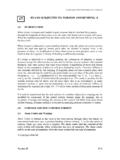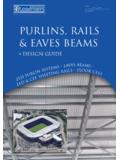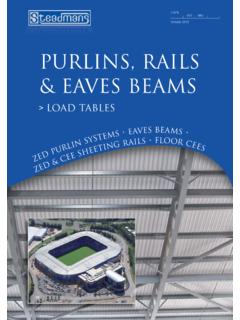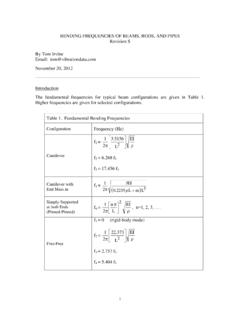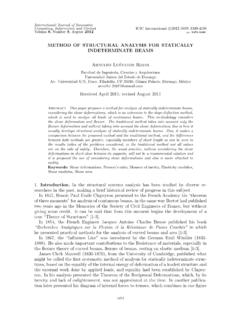Transcription of REINFORCED CONCRETE BEAMS - FREE STUDY
1 Material supplied from 1 UNIT 62: STRENGTHS OF MATERIALS Unit code: K/601/1409 QCF level: 5 Credit value: 15 OUTCOME 2 - TUTORIAL 4 REINFORCED CONCRETE BEAMS 2 Be able to determine the behavioural characteristics of loaded BEAMS , columns and struts Simply supported BEAMS : use of Macaulay s method to determine the support reactions, slope and deflection due to bending in cantilevers and simply supported BEAMS with combined concentrated and uniformly distributed loads REINFORCED CONCRETE BEAMS : theoretical assumptions; distribution of stress due to bending Columns: stress due to asymmetrical bending; middle third rule for rectangular section columns and walls; middle quarter rule for circular section columns Struts: end fixings; effective length; least radius of gyration of section; slenderness ratio; Euler and Rankine-Gordon formulae for determination of critical load You should judge your progress by completing the self assessment exercises.
2 CONTENTS 1. introduction 2. ELASTIC BENDING 3. CONCRETE BEAMS 4. SECOND MOMENT OF AREA 5. PLASTIC BENDING It is assumed that students doing this tutorial are fully conversant with bending stresses in BEAMS . Material supplied from 2 1. introduction In order to understand the theory of REINFORCED CONCRETE BEAMS you would need to STUDY a very wide range of material well beyond the scope of one part of one outcome of one module. For this reason the material offered here is greatly simplified. 2. ELASTIC BENDING Consider a simple rectangular beam at a point where the bending moment is M.
3 The neutral axis passes through the centre of area. The strain is directly proportional to distance y. Since = E the stress is also directly proportional to distance y. Suffix c refers to compression and t to tension. From the bending formula we know that the stress at the outer edge is = M y/I = M/Z y = D/2 at the outer edges. I is the second moment of area about the centroid. Z = I/y = 2I/D is the elastic modulus. (This may be looked up in standard tables for commercial BEAMS of various sections). M = Z where is the actual value of stress at the outer edge so long as it is within the elastic limit.
4 3. CONCRETE BEAMS A beam made from pure CONCRETE would fail very easily because CONCRETE cannot withstand tension so a crack would open up on the tensile edge and spread through the section. To stop this happening, steel rods are embedded in the CONCRETE near to the tensile edge. These are convoluted to help prevent them slipping in the CONCRETE . We assume that the rods are so firmly embedded in the CONCRETE that they become strained by the same amount as the CONCRETE and although the CONCRETE would break, the rods will bridge the gap and prevent the crack from opening The CONCRETE under tension does not produce any force.
5 The entire tensile force is carried by the steel rods. Material supplied from 3 The diagram shows how the stress and strain are distributed in the CONCRETE and steel reinforcement. As is the section area of the rods. The problem now is that the neutral axis moves away from the centroid and to find y we need to STUDY how to find the second moment of area when we have two materials. 4. SECOND MOMENT OF AREA The CONCRETE under compression is the shaded area and the compression force acting on this area must be equal to the tensile force in the steel rods.
6 Because of this, the neutral axis is no longer at the middle and we need a way of determiningy. For the CONCRETE section only, Ic = B(D - y)3/3 about the neutral Axis. Assuming the steel is confined to one level and that y is measured from this position, Is = As y2 This is steel and not CONCRETE and we need to find the equivalent second moment of area for the equivalent area of CONCRETE . Consider a section of steel on which the stress is . The Force is F = As and since = E The stress is s = As Es for elastic materials. Suppose the steel was replaced with an area of CONCRETE of equal strength and the same strain.
7 F = Ac Ec = As Es Ac = As Es/ Ec = As Es/Ec = n As n = Es/Ec This is the equivalent area of CONCRETE and the equivalent second moment of area is Is = n As y2 The second moment of area for the section in equivalent CONCRETE terms is 2s3 NAynA3yDBI Now consider the force balance again. The tensile force in the rods is Ft = As t = As Et t The compressive force in the CONCRETE is (D -y) B c/2 = (D -y) B Ec c/2 The tensile and compressive forces must be equal. As Et t = (D -y) B Ec c/2 yDB2nAEEyDB2A sctstc ..(1) Material supplied from 4 From the two similar triangles in the strain distribution we have y yD tc hence yyD tc.
8 (2) Equate (1) and (2) yDB2nAyyDs This may be rearranged into a quadratic equation. 0 DBAnDy2y0 BAy2ny2 DyD BAy2nyD2s2s22s2 Now use the quadratic formula to solve 2s22D c BAnD2b 1 a 2a4acbby D D yD24D42y BAnDlet 24 DBAnD4 BAnD2y2222s22ss WORKED EXAMPLE A rectangular REINFORCED CONCRETE beam has the following data. D = 155 mm B = 120 mm n = 8 As = 240 mm2 Find the position of the neutral axis and the second moment of area about it. SOLUTION Suffix c refers to CONCRETE and s to steel. 1711202408155 BAnD s rods.
9 Steel thefrom mm 2s3 NAynA3yDBI 466623 NAmm10 x x x 240 x Material supplied from 5 WORKED EXAMPLE For the same beam as example 1, the maximum strain in the CONCRETE must not exceed Determine the maximum compressive stress in the CONCRETE , the strain in the steel and the stress in the steel. Show that the tensile and compressive forces are equal. Assume the strain distribution is linear. Take Ec = 25 GPa SOLUTION Es = n Ec = 8 x 25 = 200 GPa MPa 10 x 25 E 9ccc x 10 x y 33-3ct MPa 10 x 200 E 9sss Fc = B(D - y) c/2 = {12 (155 )} x 10-6 x 75 x 106/2 = kN (compressive) Fs =As s/= 240 x 10-6 x 1054 x 106 = kN (Tensile) SELF ASSESSMENT EXERCISE A rectangular REINFORCED CONCRETE beam has the following data.
10 D = 394 mm B = 305 mm n = 8 As = 1550 mm2 Find the position of the neutral axis and the second moment of area about it. The maximum strain in the CONCRETE must not exceed Determine the maximum compressive stress in the CONCRETE , the strain in the steel and the stress in the steel. Assume the strain distribution is linear. Take Ec = 25 GPa Answers y = 251 mm from the steel rods. INA = x 109 mm4 c = MPa s = s = MPa Material supplied from 6 The work covered so far is not a very realistic approach to REINFORCED BEAMS and we should consider the theory of plastic failure and true stress distribution in order to make a realistic stab at solving beam problems.










